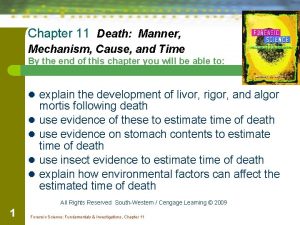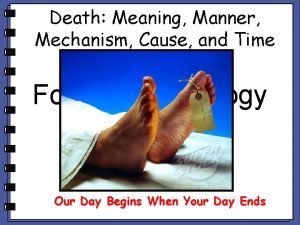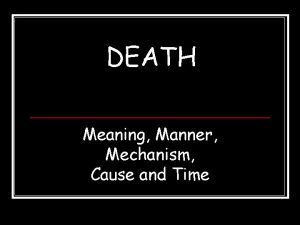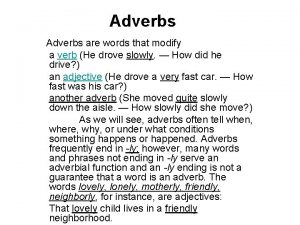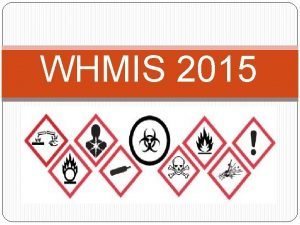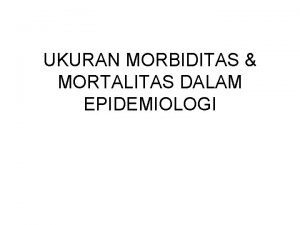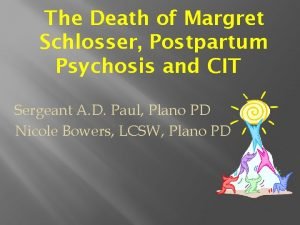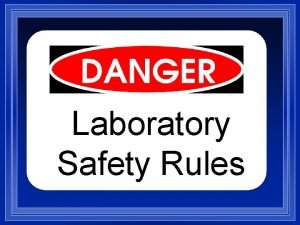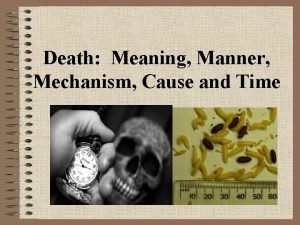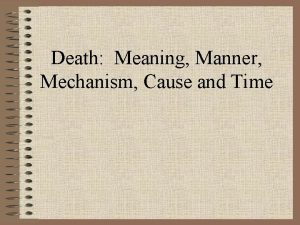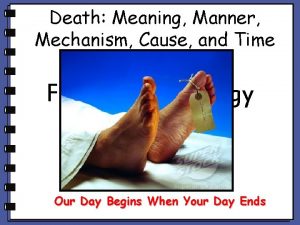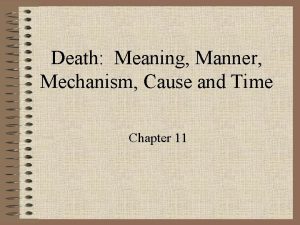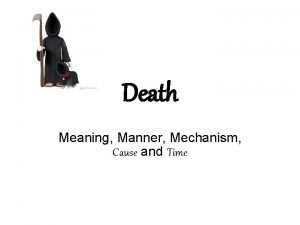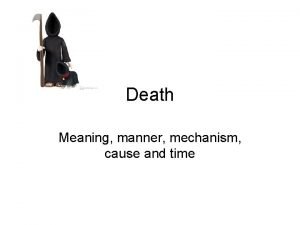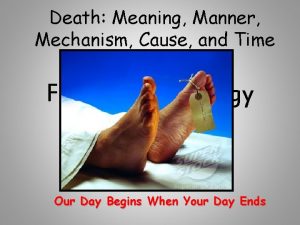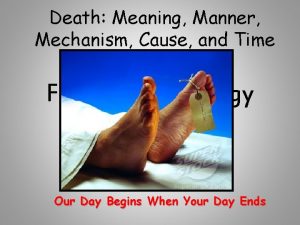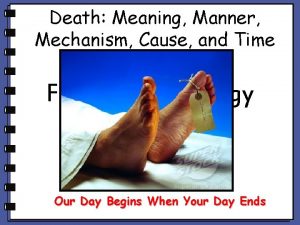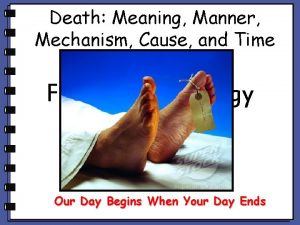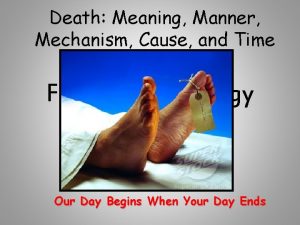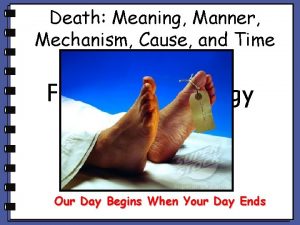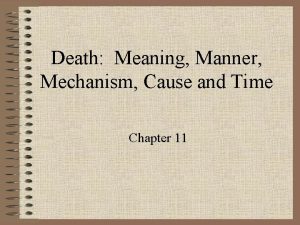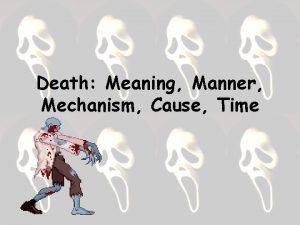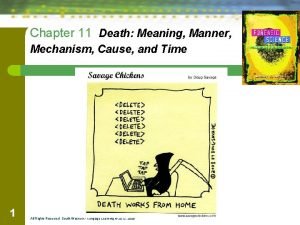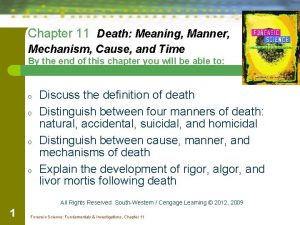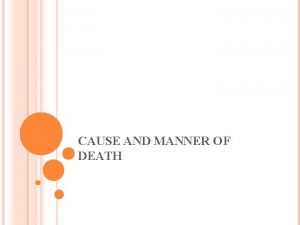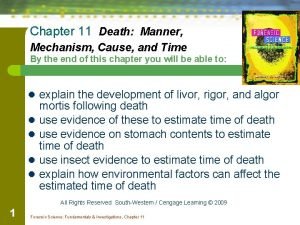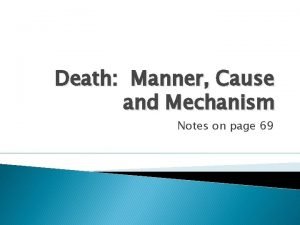Death Meaning Manner Mechanism Cause and Time Warm


























- Slides: 26

Death: Meaning, Manner, Mechanism, Cause and Time

Warm UP 10/1 and 10/2 What is a forensic pathologist?

What is a Forensic Pathologist? Specially trained physicians who are often called medical examiners or coroners. They examine the bodies of people who died suddenly, unexpectedly, or violently, and are responsible for determining the time, cause and manner of death.

Determine Time of Death — Livor Mortis livor mortis: • Process when body decomposes and blood seeps down and settles into lower parts of body. Lividity : • pooling or settling of blood in tissues after death. • Begins 2 hours after death becomes permanent after 8.

Determine Time of Death —Rigor Mortis Stiffening of the skeletal muscles after death ◦ 5 At death, skeletal muscles cannot relax. Without oxygen, calcium accumulates in these muscles. Calcium is used by the body to signal muscle contraction, this accumulation signals the muscles to contract. The muscles become stiff. Rigor mortis starts in the head and works its way down to the legs.


Determine Time of Death — Livor Mortis Livor mortis can: • Determine Time of Death • Within 2 -8 hours, can press skin and color disappears • Factors affecting lividity • Ambient temperature, anything that could impede flow of blood to area • Reveal the position of the corpse within first 8 hours • If on back, blood will pool along backside • Reveal if the body was moved • If moved, may show dual lividity from first position and then from second position

Determine Time of Death —Rigor Mortis 2 -6 hours postmortem (after death), rigor begins in the head 12 hours postmortem, rigor is complete and throughout the entire body 15 -36 hours postmortem, the muscle fibers begin to dissolve, and softening begins (rigor mortis starts to end). 36 -48 hours postmortem, rigor ends and is relaxed throughout the entire body. 8


Determine Time of Death —Rigor Mortis Factors that affect rigor mortis ◦ Ambient temperature (cold = slow rigor) ◦ The weight of the body (obesity = slow rigor) ◦ The body’s clothing or lack of it ◦ Any illness the person had at the time of death ◦ The level of physical activity at the time of death ◦ Sun exposure 10

Determine Time of Death —Algor Mortis Cooling of the body after death In death a body no longer generates warmth and begins to cool down. To find the standard temperature of a corpse, a thermometer is inserted into the liver. Time of death determined by temperature calculations is expressed as a range of time. ◦ Normal body temperature is 98. 6°F (37°C) 11

Celcius to Farhenheit conversion = (C x 9/5) + 32 = F Farhenheit to Celcius conversion = (F -32) x 5/9 = F

Determine Time of Death —Algor Mortis Calculations First 12 hours after death: ◦ Body cools 0. 78 °C (1. 4 °F) per hour After 12 hours after death: ◦ Body cools 0. 39 °C (0. 7 °F) per hour 13

Examples What is the temperature loss for someone who has been dead for 12 hours? If a corpse has a temperature of 92. 7 °F, how long has the body been dead?

Determine Time of Death —Algor Mortis Now it’s your turn … (1) What is the temperature loss for someone who has been dead for -a. 8 hours b. 15 hours c. 22 hours (2) How long has a woman been dead if, upon discovery, the temperature of her corpse is -a. 92. 3 degrees F b. 89. 1 degrees F c. 34. 2 degrees C

Determine Time of Death —Stomach and Intestinal Contents 16 4 -6 hours for stomach to empty contents into small intestine Another 12 hours for the food to leave the small intestine for the large intestine 24 hours for the food to leave the large intestine

Determine Time of Death —Stomach and Intestinal Contents Example – Determine the time of death from the last meal if food is found in the small intestine Answer: Death occurred 4 - 6 hours after the last meal 17

Exit Ticket 10/1 and 10/2 A dead woman’s body has a temperature of 33. 9 degrees C. Estimate how long she has been dead.

Warm UP 10/3 and 10/4 (1) What is the standard temperature of a living body in degrees F? Degrees C? (2) Why do dead bodies stiffen (rigor mortis)?

Determine Time of Death — Insects Forensic Entomology Forensic Entomologists study insects and their relationships to criminal investigations Within minutes of a death, certain insects arrive to lay their eggs on the warm body. ◦ Blowflies are a common example As a corpse progresses through the stages of decomposition, other kinds of insects arrive. 20


Determine Time of Death — Insects Life Cycle of Insects Collected from Dead Body Stage Accumulated Time Since Egg Was Laid (Hours) Accumulated Time Since Egg Was Laid (Days) Egg laid minutes after death 0 Larva stage 1 24 1 Larva stage 2 60 2. 5 Larva stage 3 96– 120 4– 5 Pupa 192– 288 8– 12 Adult 432– 576 18– 24 Egg

The dead body of an elderly gentleman was discovered in an abandoned building. Blowfly pupae were found on the body. A missing person’s report was filed for an elderly gentleman who had wandered away from home just two days before. The body found was similar in age, height, and weight to the missing person. Could this possibly be the same person as the person described in the missing person’s report? Explain your answer.

No, the dead body could not have been the same as the missing man. We know this because blowflies enter the pupae stage 8 -12 days after the initial eggs were laid. This means that the dead elderly gentleman has been dead for at least 8 days, and therefore could not be the missing man who wandered away 2 days ago.

EXIT TICKET The police received a report about a body found in the woods behind the local shopping center. The forensic investigator collected 5 different types of living insects on the man’s body. It’s important to stress that investigators found all 5 insects alive on the body at the same time. The insects were sent to the forensic entomology lab, where they were raised under similar conditions to those found around the dead body. The following chart describes the life cycles of each of the five different types of insects found on the dead body. How long has the man been dead? Justify your answer. Insect Blowfly Species A Species B Species C Species D 1 1 0 0 2 1 0 0 3 1 0 0 0 = no evidence of fly species 4 1 0 0 Day 5 1 1 0 0 0 6 1 1 0 0 1 7 1 1 1 0 1 1 = evidence of egg, larva (maggot) or pupa 8 1 1 1 0 1 9 1 1 10 0 1 1

Algor mortis calcuations For first 12 hours: (initial temp – final temp) / 1. 4 F or 0. 78 C For over 12 hours: initial temp – 16. 8 F or 9. 4 C (new temp – final temp) / 0. 39 C or 0. 7 F *units for final answer are always in HOURS
 Chapter 11 death meaning manner mechanism cause and time
Chapter 11 death meaning manner mechanism cause and time Algor mortis chart
Algor mortis chart Manner mechanism and cause of death
Manner mechanism and cause of death Underlying cause and immediate cause
Underlying cause and immediate cause Ultimate cause of behavior
Ultimate cause of behavior Ultimate vs proximate causation
Ultimate vs proximate causation Kinesis biology
Kinesis biology Somatic death vs cellular death
Somatic death vs cellular death Subject+verb+object+adverb
Subject+verb+object+adverb Adverb time place manner
Adverb time place manner Body decomposition
Body decomposition What is elapsed time
What is elapsed time Whmis with ghs stands for
Whmis with ghs stands for Morbiditas adalah
Morbiditas adalah Dena schlosser dead baby
Dena schlosser dead baby Lenin death cause
Lenin death cause Short exposure can cause death
Short exposure can cause death The death of the apostles
The death of the apostles Houdini death cause
Houdini death cause Peter eckersley cause of death
Peter eckersley cause of death Edward fudge cause of death
Edward fudge cause of death Portia may white early life
Portia may white early life Lyle alzado cause of death
Lyle alzado cause of death Carmen miranda death cause
Carmen miranda death cause Antonio vivaldi cause of death
Antonio vivaldi cause of death Mozart grave
Mozart grave Wolfgang amadeus mozart death cause
Wolfgang amadeus mozart death cause
